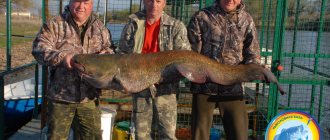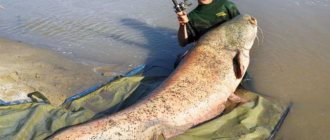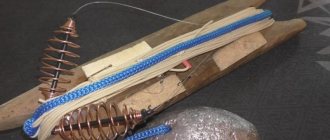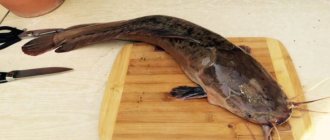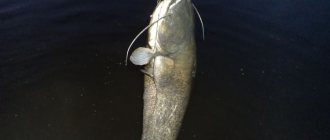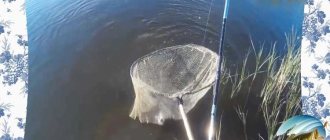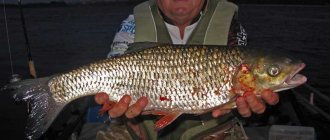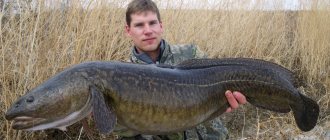Every fisherman dreams of catching a very big fish. And today, in our rivers and reservoirs, the largest representative of the ichthyofauna is the catfish. You can catch catfish with a donk, which can also be used to catch large live bait, which can later become bait for large catfish.
Catching catfish with a donk has an undeniable advantage over other methods of catching catfish. The number of bottoms can be large, so you can fish a fairly large area and find out especially promising places where catfish live.
Catching catfish on a donk in spring and summer is almost identical, try different baits. Use a bunch of worms more often in the spring.
How to make donka for catfish
The authorship of the design diagram for bottom gear with a float is www.euro-som.de.
Donka for catfish can be either with or without a rod.
Choose a strong rod with a powerful blank, since sometimes you have to resort to forced fishing. For catching catfish on a donk, special carp or sea rods are suitable. The same goes for coils.
Powerful inertia-free models of size 4000 with a large spool are best suited for equipping a donkey.
The thickness of the fishing line depends on the intended trophy. It can be braided or monofilament, the main thing is that the breaking force is greater than the weight of the catfish. Many anglers use 1 mm fishing line for bottom fishing without a rod.
The weight of the sinker depends on the strength of the current and the depth of fishing. If on a reservoir with standing water 20-50 g is enough, then for a large river - 100-200 g.
Hooks are selected to match the bait; they must be large and strong.
Choosing gear
Bottom tackle in skillful hands is a catchy tool, so it is often used when catching catfish. At the same time, the “donka” is an inexpensive device, which makes it very accessible. If we compare it with a feeder, we can note that about one dozen bottom gear is bought for this price.
There are two main types of “donoks”:
- With a rod.
- A bait that does not have a rod.
The design option that the rod has can be characterized as follows:
- For beginners, a donka with a rod is ideal;
- you should pay attention to the fact that large specimens can have a very large weight, which the fishing rod must correspond to;
- You also need to remember that the reel and line are selected based on the possible weight of the fish. If they do not match the loads, then you will not be able to catch large fish.
Often the tackle is equipped with a monofilament fishing line, the thickness of which should be selected in the range from 0.5 to 1 millimeter. The braid can be selected within the range of 0.5 to .8 millimeters. When choosing a leash, you should pay attention to the smaller diameter.
The weight of the sinker used can vary from 100 to 150 grams. The large weight of the cargo and other aspects of the gear used determine that the bait is delivered to the fishing site by boat.
The large weight of the potential catch suggests that conventional hooks will lead to the fish breaking off. The risk of a river giant descending can be significantly reduced by using two hooks.
If catfish fishing takes place on a river without the need for long-distance casting of bait, ordinary bottom gear is used, which many call casting. Its features include:
- The gear is inexpensive and simple.
- Despite the simplicity of the design, you need to have certain skills to use it. If you handle it without due care, there is a possibility of overlaps and tangling.
An important point is that after throwing the bait, the donka is tied to a tree or a driven stake on the shore.
Quite often a nylon thread is used as a fishing line, and a fishing line with a diameter of 0.5 to 0.8 millimeters is used as a leash. A single, double or triple hook, which is made of durable metal, is attached to the created leash. The size of the sting is selected in accordance with the weight of the catfish being caught.
We suggest you read: Catching predators with live bait and dead fish
The gear for catching large catfish with a kwok is quite primitive in its design. To assemble it you will need:
- a piece of the main cord made of nylon thread of at least 5–8 mm, in a volume of 20–30 meters;
- wooden reel;
- sliding lead weight in the form of an olive or cone;
- a powerful single, sharpened hook, with a tip bent inside the bend of the accessory.
For the convenience of fishing and comfortable landing of fish, somyatniks adapt powerful fishing rods for nodding, equipping them with reels of various types, the spool of which can accommodate the volume of line used for fishing and help fight fish with the help of a reliable clutch. Fishing rods used are short in size, no more than two meters, with high weights, starting from one hundred grams, and reinforced rings.
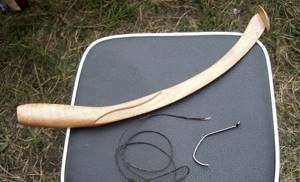
It is important to choose strong hooks
The reel is more convenient, inertia-free, with high traction force and a strong clutch mechanism. Lead weights are selected in masses based on the strength of the current. With powerful flows, the load can reach even five hundred grams. In calm sections of the river and in backwaters, 50–70 gram olives are enough. The stopper for the sinkers is placed 70–100 cm from the hook, thus creating a kind of leash for the bait, regardless of its state, active, like a live bait, or passive, like a shell strung on a hook.
Baits and lures for catfish
Catfish are omnivorous fish, but their diet changes with age.
For small catfish, the best baits are:
- leeches;
- crawls;
- shells.
Larger individuals feed on:
- frogs;
- small fish;
- crayfish.
Giant catfish eat:
- mice;
- large fish;
- waterfowl;
- small animals.
In addition, the fisherman should take into account that the catfish performs the function of an orderly for reservoirs and rivers. He does not disdain food with a “flavor”, and, having a good sense of smell, senses such food from a great distance. That’s why experienced bait fishermen deliberately spoil baits so that they have a rotten smell.
Fishing for crayfish
When studying the stomach contents of caught catfish, fishermen often find crayfish shells. This suggests that such bait will be a real delicacy for the fish.
The most difficult part of fishing with this bait will be finding the crayfish. Some fishing stores sell crayfish, and if you can’t buy it, you have to catch bait with claws using crayfish traps.
You can adapt a regular lift for catching fry by tying an appetizing bait, for example, a frog roasted over a fire, in the center of the net.
Video about catching catfish with kwok in an extensive guide on our website. You will learn how the tackle is constructed, how to properly make and use the quok in practice.
Catching bream on a feeder - how to catch large live bait for catching catfish and just a trophy broad-backed giant.
List of gear needed for catfish fishing.
Catching large catfish on Akhtuba in Trekhrechye
It's no secret that catfish, the largest freshwater predator in our reservoirs, has always been a coveted trophy for fishing fans, both professionals and

lovers. He rightfully leads the so-called “Big Three predators” in the catch: catfish, pike perch, pike. This is due to the fact that catching catfish and the very process of fishing for such large prey is more reminiscent of hunting an animal.
Despite the fact that catfish in the Lower Volga have always been distinguished by their rather large size, Akhtuba catfish often turn out to be giants even among their relatives. The catfish reaches such dimensions on the Akhtuba and its tributaries (Mangut and Kharabalyk) due to the terrain, mild climate and abundant food supply. That is why many fans of catfish fishing come here to get their trophy, to Akhtuba in the Trekhrechye region.
By the way, trophy catfish, weighing from 40 to 100 kg, in Trekhrechye are still regularly caught by fishing fans. This is evidenced by photographs of guests of the Trekhrechye fishing base taken over the last 3 years (illustrations for this article). Of course, you can’t take such a beast “on the ball” - you need experience, special gear and considerable patience. But the reward in case of success will be a sea of impressions and adrenaline. Lifting a catfish even weighing 15-20 kg, especially during warm water periods, is an activity for real men.

When is catfish caught?
You can start catching catfish as early as mid-April, when it begins to leave its wintering holes and begins to actively feed in order to replenish losses after a long winter torpor. During this period, the catfish is still slow due to the low water temperature and the fisherman is required to first find a place where it is “lying” (as a rule, these are exits from deep channel holes), and then hold an artificial bait literally under the very nose of the mustachioed giant or throw a catfish bait , as they say, straight to the table. Adult catfish feed mainly on fish, crayfish, frogs and invertebrates, but often attack unwary water birds and rodents.
At the beginning of the flood, in the last days of April, catfish are no longer caught, and in addition, a spawning ban on catching aquatic biological resources comes into force. But with the decline in water in early June, the “mustached” catfish becomes active again and its bite reaches its peak in hot July - it is in July that the largest specimens of Akhtuba catfish are caught. During this period, the predator searches for prey not only near its lair, but also goes out to hunt at night over fairly large distances, on shallows and underwater spits. In August, in the Lower Volga there is a decline in catfish activity again and its capture is rare.
With the beginning of autumn, catfish are caught steadily on Akhtuba, and at this time they feed very actively, often sneaking up and chasing their prey over long distances. This continues until the onset of November cold weather, when the catfish go to wintering pits and practically stop feeding.
With the appearance of ice, the catfish falls into torpor and does not feed at all until spring, spending all its time in deep channel holes.
How to catch catfish in the Lower Volga?
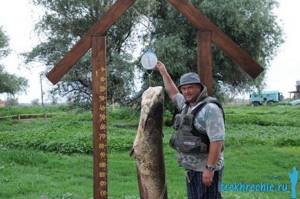
There are several main ways to catch catfish:
— Catching catfish using a quok from a boat;
— Catching catfish on a donk from the shore;
— Catching catfish using a spinning rod “on the track” or trolling;
— Catching catfish with mugs and “sets.”
Usually, somyat fishermen specialize in one particular method, since it requires specific gear and skill.
So, for example, when fishing with quok from a boat, you need a good knowledge of the bottom topography or an echo sounder in order to conduct reconnaissance and determine possible places for catfish “beds.” Next, the fisherman sets up side fishing rods with bait (fish, crayfish, frog, poultry, tripe) and a special decoy, quok, and begins to make a series of strikes on the water. A gurgling sound produced at a certain frequency attracts catfish to the fishing spot. Often its approach can even be seen on the echo sounder.
Fishing with bottom gear from the shore can be no less interesting, especially if the angler knows the fishing spot well and can predict the appearance of a hunting catfish in advance. It is especially interesting to catch catfish on donkeys during the period of night activity. In this case, live bait, a frog, crayfish or a bunch of large crawling worms are also used as bait.
Using the same bait, they catch catfish in circles , which are placed over holes and in backwaters where catfish appear, but this method is only suitable in places where there is no current. In addition, you need to constantly monitor the mugs, otherwise the spotted catfish will simply go into the snag, from where it is almost impossible to remove it without breaking the tackle.
The most catchy and active method, which also allows you to catch the largest “channel” catfish specimens in the current, is trolling . In this case, artificial bait (deep-sea wobblers) or live bait on a rig with a load is towed behind the boat at a distance of 60-80 meters at a minimum speed. Having identified the most promising areas of holes and edges in advance, the bait is brought above the very bottom. In this way, it is possible to catch in a minimum time the maximum areas of the channel where the catfish can be located at the moment.
Catfish fishing gear
The selection of gear for this difficult task is the main criterion for successful fishing, since it is not enough to catch a catfish - it also needs to be “lifted,” that is, taken to a boat or to the shore. And this mustachioed predator knows how to resist. There are often cases when the fight with large, more than 50 kg, catfish took hours. If a catfish accidentally “sits” on light or medium spinning tackle, there is little chance of getting it out, especially if the angler does not have enough experience - sometimes it is better to give up the fight in order to keep the expensive rod and reel intact.
Therefore, the basic rules for selecting gear for catfish fishing are as follows:
— spinning rods must be “oak”, that is, as durable as possible;
— as a fishing line, it is better to use braided cords 0.25-0.40 with a leash, since the “braid” is afraid of damage from sharp shells or can be “rubbed” by hard brushes in the catfish’s mouth, especially during long-term fishing;
— hooks for catfish use large, usually single or double (anchors) with a long shank and always forged, of the highest quality;
— sinkers for bottom fishing for catfish are used in a streamlined shape (sinkers of the “Tyrolean stick” type have proven themselves well) and always with a leash or fastener, half as strong as the main fishing line. In case of a snag, having lost the sinker, you will save the rest of the tackle;
- from the necessary means at hand, you need to have a strong hook. In addition, some “somyatniks” use a wooden mallet - a blow from the front to the face puts the catfish into a stupor for several minutes and makes it easier to drag it into the boat.
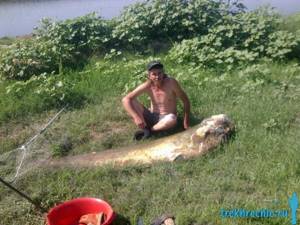
Fishing for large catfish
The bite of a large catfish is usually not very aggressive, there is no characteristic strike, but rather feels more like a dead hook on a snag or driftwood. For a few seconds, the catfish can “chew” the captured prey, after which it begins to quickly swallow - at this moment it can be hooked. The catfish usually sits firmly on the hook thanks to the durable fleshy tissues lining the mouth. There is no need to rush into fishing; you should get your bearings on the spot and outline an action plan. If the catfish is very large and lies down, you can try to lift it from the bottom by hitting the rod under pressure. Under no circumstances should the catfish be allowed to go into a snag - the prey and tackle will be lost.
The caught catfish, if you managed to drag it into the boat (which does not always happen), should be covered with wet
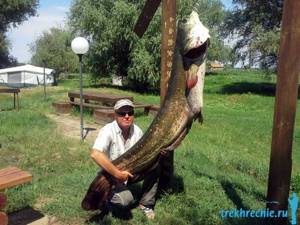
with a burlap sack from his head - so he falls into a stupor and does not resist. If possible, it is advisable not to drag very large specimens, weighing more than 60 kg, into the boat (in such a situation, fishermen often get injured), but to wear them down by fishing and tow them to the coastal shallows, where this procedure is much easier to perform.
But in any case, if you decide to try your hand at such serious fishing, it is better to first join more experienced colleagues or take a professional huntsman as your accompaniment. This will not be difficult to do at the Trekhrechye fishing base.
Happy fishing in the new season!
More
Fishing with a frog
Frog is one of the most popular baits for catfish.
They hook it by the hind legs with the sting up. To prevent the bait from being too active, you can use a double hook, placing the frog on both legs. Then she will only crawl along the bottom. The easiest way to catch frogs is in the evening, when it gets dark, and to ensure that the jumping frog does not offer resistance, use the following proven method:
Having found a frog, you need to point a flashlight beam at it, after which you can pick up the frog with your hand. You can use a landing net to catch frogs.
Fishing with a worm
It is best to start catching catfish with a donkey with such a simple bait as a worm. To do this, a bunch of any worms or crawlers is strung on a large hook with a long shank.
Of course, it is unlikely that you will be able to catch a trophy fish, but you will be able to get acquainted with the habits of catfish. The donk can be equipped with two hooks, and a feeder can be mounted to attract fish.
The bait will be a mixture of earth and chopped worms. Often the by-catch includes fish such as ide, bream, and perch.
Fishing with live bait
Since catfish is a predatory fish, it can also be caught using live bait. Fish of different sizes fall prey to catfish. Fishing with live bait is carried out at night; there are usually bites on half of the installed bottom gear.
Any fish caught during the day is suitable as live bait. You can bait a fish on a hook by the lip or the back.
Fishing for crucian carp, what baits and bait to use, how to look for a place and the secrets of a good bite in the guide on EarlyUtrom.com.
Everything about carp fishing, from fishing methods to baits and bait.
About catching crucian carp with a float rod in the article about mixing bait, the best bait and choosing a promising fishing spot.
Baits
The choice of bait for this type of fishing is guided by the presence of a strong odor and volumetric dimensions, clearly noticeable in the water column. Baits for catching catfish with quok can be either mobile or inert. Moving baits include all kinds of live bait and preferably carp fish species with large scales.
Crucian carp, carp, ide, roach in sizes from 15–20 cm and weights from 200 grams are noticed by the predator both visually and by the vibrations of their movements. They put the fish on a hook behind their back and let them swim freely on a long leash. A crawler is used from inert live baits, stringing it in a large bunch on a hook or large leech.
In river lamprey habitats, its use as bait is justified in most cases. It is effective to equip the quok with specially prepared baits in the form of a bird singed with feathers, a whole frog burned by fire, or toothless meat and pearl barley. The cooked bodies of mollusks are tightly strung on a hook, forming the bait into a massive ball, and in this form they are served to the fishing mark.
Finding a place to catch catfish
It is necessary to catch catfish on a donk in deep holes. You can find them on sharp bends of the river by making several test casts. Having a boat with an echo sounder will make finding a fishing spot much easier. Another way to find a catfish den is to tactfully ask local fishermen.
The area adjacent to the pit is also promising for fishing. Usually catfish hunt at the same points. So, having figured out where the fish are coming out in one night, you can safely go fishing here next time. Some of the donks should be placed under trees, near reeds and water lilies.
Fishing depending on the season
When taking a professional approach to catfishing, you must take into account the season. This will help you not only get a rich catch, but also get an unforgettable pleasure from fishing or, perhaps, catching the largest trophy.
Features of hunting for catfish in spring include:
- After winter, the fish are hungry and pay attention to all baits. In addition, appetite increases significantly before spawning.
- It is possible to catch large specimens.
- Only after the water warms up to 10 degrees Celsius does the catfish emerge from its winter holes and begin to actively hunt.
- The fish behaves carefully and does not swim far from the pits where they spent the winter.
- Fishing is active exclusively during the daytime.
- Catfish bite best in shallow water.
In autumn, the behavior of fish changes significantly. When going fishing, consider the following:
- active hunting takes place exclusively at night;
- after summer the fish becomes calmer, attacks exclusively from ambush;
- The most suitable time for fishing is September. With the onset of severe frosts, the catfish freezes and stops feeding;
- In search of food, the fish comes to the shore.
In the summer, fishing is a little different. Features of fishing in summer include:
- Only small specimens can be caught with a fishing rod.
- The fish hides throughout the reservoir and comes out to hunt only at night.
- In hot weather, it is recommended to fish in the morning from 3 to 9 o'clock, in the evening - from 18 to 23 o'clock.
- In the morning, catfish hunt at great depths, in pools or holes.
- At night, loud splashes can be heard as the fish become more active.
We invite you to read: Fishing for pike perch: how to catch, what they bite on, bait, tackle and methods of catching pike perch
This way, catfish hunting can be very entertaining and productive. To summarize, the following points should be noted:
- Donka fishing brings good results;
- the bait is selected depending on the weight of the fish expected when fishing;
- The fishing technique depends on the time of year.
Taking into account the above information, you can significantly increase the chances of catching a large catfish. And the obtained trophy is a source of pride for any fisherman.
Features of catching catfish from the shore
When bottom fishing from the shore, you should adhere to the following tactics.
First, the most promising places for fishing are selected. The fisherman spends most of his time in such places. The rod must be securely installed on stands, the reel clutch must be loosened. The tip of the rod, which is equipped with a firefly or bell, acts as a bite alarm.
Be sure to provide an area for landing large fish before dark.
In local places you can use donks without rods. It is only important to securely fasten the fishing line to a suitable support (bush, tree).
How to catch catfish using kwok
Preparation for fishing, in addition to identifying promising hunting areas, should also include equipping the boat with the necessary auxiliary equipment in the form of a hook for fixing and lifting the trophy on board, a rubber sledgehammer, the so-called humanizer, for putting fish to sleep and a strong synthetic rope with a diameter of about 3 cm, which is used for towing fish.
When approaching the hunting point, equipment loaded with bait is lowered under the boat, to a depth of five to seven meters, and slowly floated downstream, periodically quoting to lure catfish. The kwoka technique is performed with three consecutive strikes with a pause of fifteen seconds between these periods. The boat is driven level above the hole, trying to reduce noise levels to a minimum.
They pass the fishing zone two or three times, moving to the next promising place if there are no bites. You can return to the fished area again after two or three hours, repeating passes. The contact of the predator with the bait is felt as a powerful push followed by a pause. After waiting a pause and feeling the pull, the angler must sharply hook the fish and begin fishing.
Boat fishing technique
Catching catfish with bottom tackle from a boat has its pros and cons.
The advantages include being close to the fishing point, accurately delivering the bait, and using short tackle with a thinner line.
The disadvantage of fishing is the awkward position of the fisherman, the restrictions when fishing at night, and the difficulty of landing trophy fish. Going out to catch catfish on a rubber boat alone is very risky. If you take a large catfish, then the riding experience will not be the most pleasant.
